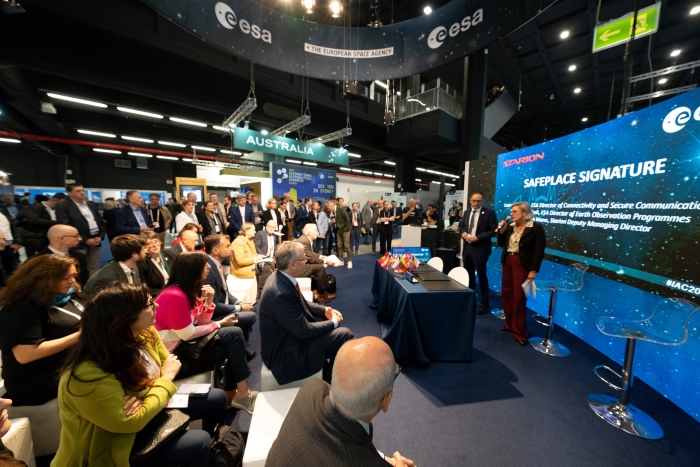ESA to enhance space-enabled crisis management with Safeplace

ESA, in partnership with a Starion-led industrial consortium, launched a project to develop a new space-enabled service for crisis response. The industry-initiated project, named Safety Platform for Crisis and Emergency (Safeplace), forms part of ESA’s Civil Security from Space (CSS) programme.
The project aims to build a digital platform through a space-enabled federated system, supporting the needs of public safety stakeholders during crisis events. The system will be built to manage and improve crisis management of any scale and in any region where the system is implemented and operational, even in areas where (global navigation satellite system) GNSS positioning is unavailable.
The system will orchestrate bringing together data sources from both ground and space assets, acting as an interface to processing platforms to handle data, as well as hosting applications. Safeplace will enable stakeholders to make quicker and more confident decisions through more easily identifiable key information, rather than dealing with different data bottlenecks and sifting through unnecessary raw data.

As part of the CSS programme, Safeplace will continue the programme’s commitment to maximise its value in providing solutions for various use cases and users. The project is envisioned to serve crises scenarios such as chemical incidents, flooding, humanitarian challenges, fires, and earthquakes.
Leveraging advanced Earth observation (EO), satellite-based positioning of personnel and assets, Internet of Things (IoT) data and satellite communication services, Safeplace will provide situational awareness information for early crisis and crisis response phases, with some pre-crisis management envisioned for fire-based crises.
To ensure Safeplace remains future-facing, technologies such as AI processing and machine learning, big data analytics and fusion, and IoT sensor networks will be implemented, giving users certainty in the effectiveness and flexibility of the system. The ESA project will serve to validate the core technologies that will enable the system solution. Four demonstrations will take place in Belgium and Spain over a 3-year development programme.

The project brings together a European consortium of nine companies from Belgium and Spain; Starion (prime), Public Safety Communications Europe (PSCE), VOCSens, VITO, neXat, Centre Spatial de Liège (CSL), ST Engineering, Epic Blue (all Belgium) and Vodafone (Spain). It also includes several supporting organisations from Belgium, Germany and Spain to provide valuable input on real European operational crisis management use cases and to ensure the system covers all needs across the value chain from service providers to end-users.
Nicola Mann, Starion Deputy Managing Director said: “There is an increasing need to deliver detailed, accurate and need-specific information to first responders as fast as possible when a crisis occurs, as we have seen in Europe in recent years when, for example, increasing numbers of severe flooding and fire events have occurred, causing loss of life. Satellites can provide complementary and necessary data, and our advanced data engineering and AI capabilities will allow us to rapidly convert this data to actionable information."
“The Safeplace Hub will act as a secure portal to data and services provided by third parties. We are developing a single interface to these multiple information sources that will give more precise situational awareness to operators, for example overlaying near real-time data about responder positions on the latest EO imagery, and applying AI to drone video footage to determine the likely location of victims. Then the Hub will enable the information to be delivered fast, via satcoms where appropriate, enabled by the BESecured satcom pooling and sharing service, which is the result of a previous project Starion worked on with neXat and ST Engineering.”
"We're proud to be launching the Safeplace project," said Laurent Jaffart, ESA’s Director of Connectivity and Secure Communications. "This project showcases Europe’s technological and industrial capabilities to benefit European citizens. By improving our ability to respond to challenges ranging from natural disasters to humanitarian crises, we're taking a significant step towards a safer and more resilient Europe."
“Crises and emergencies are, by their very nature, unexpected,” said Simonetta Cheli, ESA Director of Earth Observation. “However, through developments such as Safeplace, we can ensure that satellite-based situational awareness, communications and location capabilities contribute effectively and reliably in enabling first responders to maximize the impact of their response.”
The CSS programme brings together the ESA directorates of Connectivity and Secure Communications, Earth Observation and Navigation to improve civil security and crisis management responding to natural disasters, critical infrastructure failures, maritime safety, accidents and emergencies, pandemics and humanitarian challenges. It develops an interoperable space and ground-based network to complement and strengthen existing terrestrial systems, improving Europe's resilience and ability to respond.


